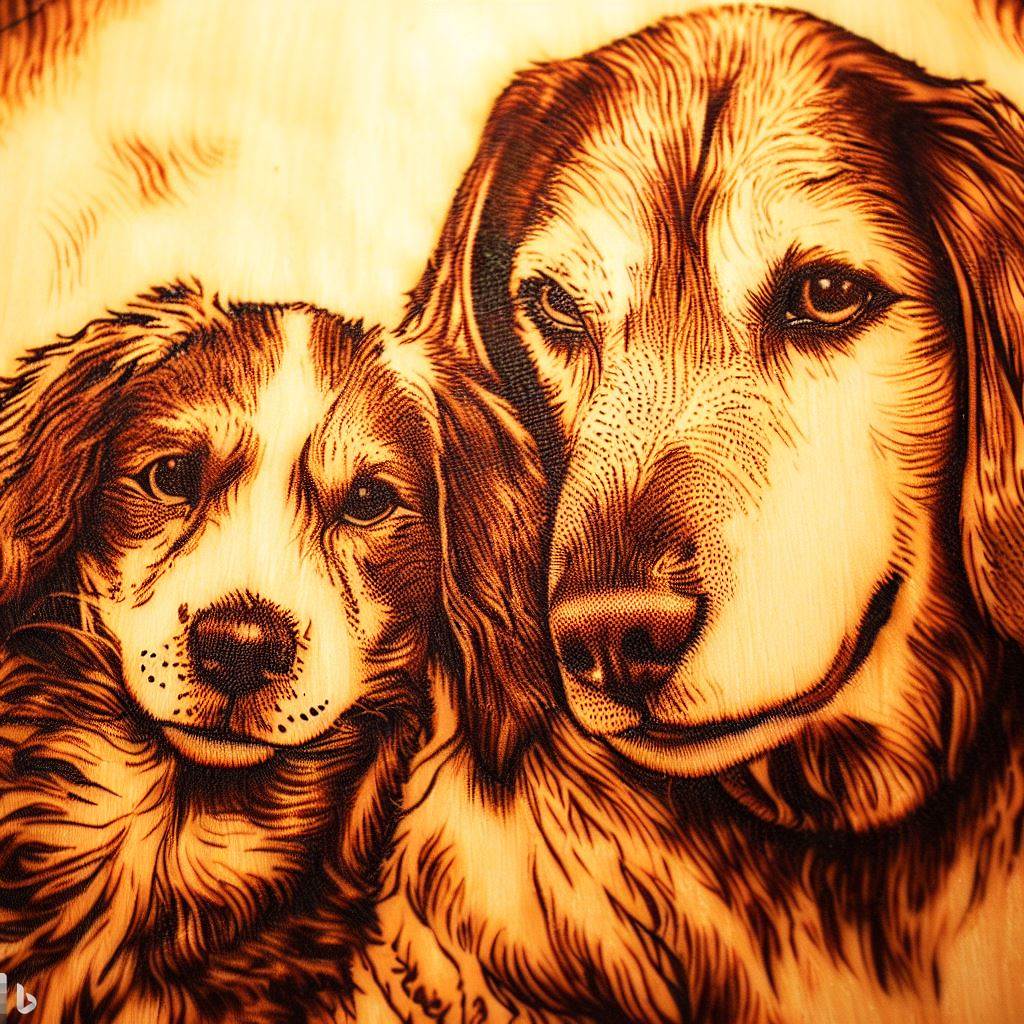Pyrography for Pet Portraits: Tips for Burning Dogs, Cats and Other Pets into Wood
For pet owners, few mementos are more meaningful than a custom hand-rendered portrait of a beloved companion animal. Pyrography’s ability to replicate fine textures makes it an ideal medium for capturing animals’ unique coats, expressions, and spirits on wood. Yet the intricacies of fur, whiskers, paws, feathers, and scales demand patience and specialized techniques. While pet portraits require pyrographers to pay keen attention to detail and anatomy, the rewards are priceless. With careful burning mimicking the nuances of each creature’s features, pyrographers can create stunning tributes preserving pets’ quirks in wood long after they’re gone. Cherished cats, dogs, horses, birds, and exotic pets can all come to life through heartfelt pyrography pet portraiture.
Why Pyrography Excels at Pet Portraitures
Several inherent qualities make wood burning well-suited for depicting animals:
- Ability to replicate exceptionally fine and realistic textures like fur and feathers.
- Capacity for accuracy capturing proportions, anatomy, and poses.
- Skill mimicking subtle contours of musculature and structure.
- Range achieving tonal nuance through gradations from light to shadow.
- Control over line to illustrate fine details like whiskers.
- Potential for eliciting emotions and mood of animal through expression.
- Warmth and versatility accepting color additions if desired.
Pyrography possesses all the artistic assets to honor cherished pets through poignant portraiture.
Keys to Capturing Pet Likeness in Pyrography
Achieving an authentic portrayal relies on mastering these core components:
- Anatomy – Burn underlying skeletal and muscular forms accurately. This supports proper proportions.
- Perspective – Locate eyes level with viewer for direct engagement.
- Expression – Capture personality through eyes, ears, mouth, and overall demeanor.
- Coat Texture – Mimic unique fur, feather, or scale patterns.
- Natural Posture – Reference photos showing typical stances.
- Settings or Props – Include memorable toys, beds, or surroundings.
Every realistic detail adds up to breathing life into beloved companions.
Helpful Tips for Burning Dog Portraits
Mastering canine textures and features makes for satisfying pyro dog tributes:
- Note fur length – long, short, curly, wire – and burn coat accordingly. Accent tufts on ears, chest, feet.
- Recall that dogs focused forward. Burn eyes, nose, and ears facing front.
- Angle jaws slightly open to replicate panting and smiles. Vary teeth showing.
- Capture muscle definition of chest, shoulders, haunches, and other areas.
- Remember expressive eyebrows, forehead wrinkles, and long nose profiles.
Dogs’ playful personalities translate beautifully into pyrography.
Techniques for Realistic Cat Portraits
Cats present their own textural and postural considerations:
- Light scumbling mimics short fine fur. Use tiny zigzags for velvety ears.
- Note bits of fluffiness around cheeks, belly, paws. Accurately burn tiger stripes or calico spot patterns if present.
- Position paws tucked under body or dangling. Show relaxed or alert ear direction.
- Render extra long whiskers with delicate yet controlled stroking.
- Reveal cats’ more angular features like almond eyes, pointy ears.
Subtly burn cats’ independent character and soft fluffiness.
Tips for Other Pets and Animal Portraits
Unique species demand specialized approaches:
Horses: Show muscled haunches, manes, long face profiles. Soften eyes.
Birds: Focus on feather texture variations on body, wings, crest. Feature bright eyes.
Reptiles: Develop intricate scale textures. Burn gradual blending along the scales.
Rodents: Concentrate on fluffy fur. Ensure paws and whiskers are precise.
Livestock: Note floppy ears, rough fuzzy coats, squarish muzzles when burning goats, cows, pigs.
Regardless of subject, honor distinctive qualities with careful burning.
Helpful Techniques for Pyrography Pet Portraits
Thoughtful process enhances overall portraits:
- Sketch composition using grid method for perfect proportions before burning.
- Identify darkest darks and lightest lights. Gradually layer values between.
- Begin with larger masses – body shape, head. Then refine details.
- Work slowly and patiently. Fur textures demand focus and time.
- Burn directionally following coat grain for realism.
- Finish by softening lines and enhancing eyes, nose, and expressive accents.
Meticulous layering and control results in living warmth.
Effective Ways to Photograph Pets for Reference
Quality reference photos ensure accuracy:
- Get eye level and shoot straight on for direct connection. Avoid looming overhead.
- Use treats or toys to capture alert natural expressions. Catch ear and whisker positions.
- Try multiple angles – profile, 3/4 views, full body, close ups of face.
- Focus on well-lit, sharp details. Avoid blur from motion or bad lighting.
- Look for memorable moments that capture pets’ quirky personality.
- Snap many images to have options showing favorite attributes and activities.
Thorough photo references make capturing every adorable nuance easier.
Common Pet Portrait Pitfalls to Avoid
Steer clear of these habits that cause distortion:
- Incorrect proportions – Heads too small, distorted leggy body shapes. Measure carefully.
- Flat lighting and shading – Adds proper dimensions with bold contrasts.
- Forgetting textures – Fur, whiskers, etc. bring subjects to life. Don’t simplify.
- Odd expressions – Reference familiar views that capture true personality.
- Over-burning fine details – Stay delicate preserving fins, grass, feathers.
- Distracting backgrounds – Isolate subject or burn natural complementary settings.
Regular comparisons to photo references safeguard accuracy.
With practice and care, pyrographers can create deeply meaningful keepsakes capturing beloved pets’ spirits for posterity. Though challenging, portraying animals provides excellent artistic training demanding close observation of textures and anatomy. The resulting wood burned artwork memorializes cherished bonds for a lifetime.
